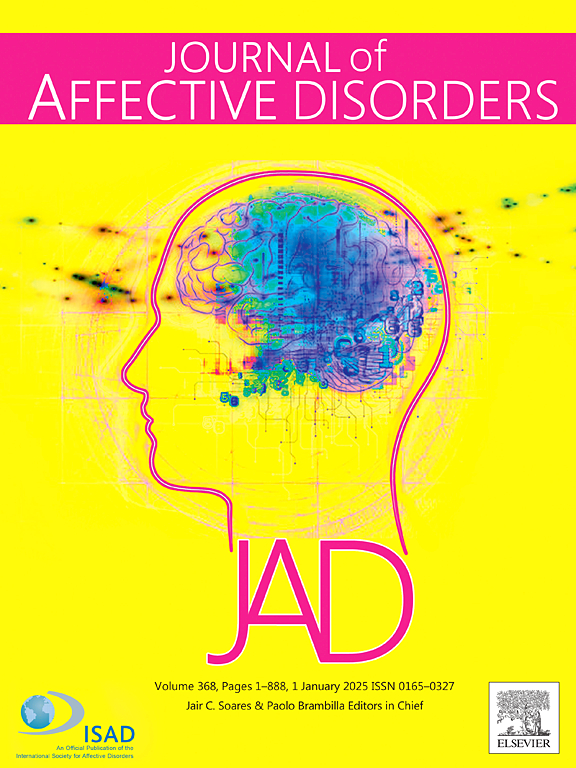Naturalistic psychedelic use and changes in depressive symptoms
IF 4.9
2区 医学
Q1 CLINICAL NEUROLOGY
引用次数: 0
Abstract
While growing evidence suggests that psychedelic-assisted therapy may have antidepressant effects in certain populations, little is known about the effects of psychedelic use on depressive symptoms in non-clinical, naturalistic settings. This observational cohort study included a large sample of US residents (18–50 years old) and longitudinally evaluated the relationships between naturalistic psychedelic use and changes in depressive symptoms. 21,990 participants completed the T1 survey and 12,345 completed the T2 survey (56.1 % retention). In total, 505 participants (i.e., 4.1 % of T2 survey completers) reported psychedelic use during the study period. The covariate-adjusted models showed a modest association between psychedelic use during the study period and increases in depressive symptoms (β = 0.12, p = .019). When disaggregated by context of use, psychedelic use in a ‘risk context’ (e.g., negative mindset prior to psychedelic experience, no psychological support present during psychedelic experience) was associated with moderate increases in depressive symptoms relative to no psychedelic use (β = 0.30, p < .001) and psychedelic use not in a ‘risk context’ (β = 0.27, p = .004). Notably, psychedelic use in a ‘risk context’ was strongly associated with having a more challenging psychedelic experience (β = 0.59, p < .001), which in turn was associated with modest increases in depressive symptoms (β = 0.16, p = .007) and accounted for the association between psychedelic use in a ‘risk context’ and increases in depressive symptoms. In conclusion, the findings suggest that naturalistic psychedelic use may not be generally therapeutic and may result in worsening depressive symptoms under certain circumstances. Future epidemiological research should further investigate factors associated with worsening depressive symptoms following naturalistic psychedelic use.
自然致幻剂的使用与抑郁症状的变化
虽然越来越多的证据表明,致幻剂辅助疗法在某些人群中可能具有抗抑郁作用,但在非临床、自然环境中,致幻剂对抑郁症状的影响尚不清楚。这项观察性队列研究包括大量美国居民(18-50岁),并纵向评估自然致幻剂使用与抑郁症状变化之间的关系。21,990名参与者完成了T1调查,12,345名参与者完成了T2调查(保留率为56.1%)。总共有505名参与者(即占T2调查完成者的4.1%)报告在研究期间使用过迷幻药。协变量调整模型显示,研究期间致幻剂使用与抑郁症状增加之间存在适度关联(β = 0.12, p = 0.019)。当按使用环境分类时,在“风险环境”中使用迷幻药(例如,迷幻体验前的消极心态,迷幻体验期间不存在心理支持)与不使用迷幻药相比,抑郁症状的中度增加相关(β = 0.30, p <;.001)和非“危险环境”的致幻剂使用(β = 0.27, p = 0.004)。值得注意的是,在“风险环境”中使用迷幻药与更具挑战性的迷幻体验密切相关(β = 0.59, p <;.001),这反过来又与抑郁症状的适度增加有关(β = 0.16, p = .007),并解释了在“危险环境”中使用致幻剂与抑郁症状增加之间的关联。总之,研究结果表明,自然致幻剂的使用可能不是一般的治疗,在某些情况下可能会导致抑郁症状恶化。未来的流行病学研究应进一步调查自然致幻剂使用后抑郁症状恶化的相关因素。
本文章由计算机程序翻译,如有差异,请以英文原文为准。
求助全文
约1分钟内获得全文
求助全文
来源期刊

Journal of affective disorders
医学-精神病学
CiteScore
10.90
自引率
6.10%
发文量
1319
审稿时长
9.3 weeks
期刊介绍:
The Journal of Affective Disorders publishes papers concerned with affective disorders in the widest sense: depression, mania, mood spectrum, emotions and personality, anxiety and stress. It is interdisciplinary and aims to bring together different approaches for a diverse readership. Top quality papers will be accepted dealing with any aspect of affective disorders, including neuroimaging, cognitive neurosciences, genetics, molecular biology, experimental and clinical neurosciences, pharmacology, neuroimmunoendocrinology, intervention and treatment trials.
 求助内容:
求助内容: 应助结果提醒方式:
应助结果提醒方式:


